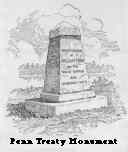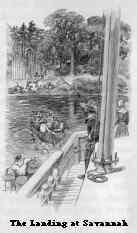Resource Center OLLibrary
|
104 |
|
[1682 |
By the "Great Law" it was provided:
1. That all colonists should be protected in
their worship of God, but that no one should be compelled to
support or attend any form of worship against his
will.1
2. That all resident taxpayers should have the
right to vote, and that every member of any Christian church might
hold office and become a member of the legislative
assembly.2
3. That every child, after reaching the age of
twelve, should be brought up to some trade or useful
occupation.
4. That the death penalty should be inflicted
for two crimes only, instead of for two hundred, as in England;
those two were murder and treason.
5. Furthermore, it was ordered -- perhaps for
the first time in the history of the world -- that every prison
should be made a workshop and a place of
reformation.3
122. The Great Treaty; Growth and Importance
of Philadelphia. Penn's next act (1682)4 was a
treaty with the Indians. According to tradition he met the Red Men
under the branches of a wide-spreading elm in what was then the
vicinity of Philadelphia.5 There solemn promises of
mutual friendship were made. In accordance, however, with the
principles of the Quaker faith, no oaths were taken (§ 83).
Each trusted to the other's simple word.
That treaty was "never broken," 6 and
for sixty years, or as long as the Quakers held control, the
people of Pennsylvania
1 No person believing
in God and living peaceably and justly "shall in any wise be
molested." -- The "Great Law," Section I, Hazard's "Annals
of Pennsylvania.
2 This is according to Section 65 of
The "Great Law"; but Section 2 of the same would appear to
limit the right to elect members to the assembly to "such as
profess and declare they believe in Jesus Christ."
3 The prisons of Europe at that time
were dens of idleness and disorder, and the criminal usually came
out actually worse than he went in.
4 See Hazard's "Annals of
Pennsylvania," p. 635; but some authorities fix the date at 1683
and consider the treaty to have covered the purchase of lands.
5 The treaty was made at Kensington,
in the northeastern part of the city. The Treaty Elm was blown
down in 1810. So great was the regard for the old tree that during
the Revolution, when the British forces occupied Philadelphia,
General Simcoe, their commander, stationed a sentinel under it to
prevent his soldiers from cutting it down for firewood. The
monument marking the spot where it stood is on the west side of
Beach Street, north of Columbia Street, Kensington.
6 Voltaire, the French historian,
said that it was "the only treaty which was never sworn to and
never broken"; if he had heard of Carver's treaty (§ 74), he
would have mentioned that too.
|
1682- ] |
|
105 |
|
lived at peace with the natives. The site of the tree
under which that memorable transaction took place is
|
|
106 |
|
[1733 |
XIII. GEORGIA (1733)
124. Oglethorpe's Project for the
Settlement of Georgia; his Three Objects. Many years after
Penn founded his colony the English general James Oglethorpe, with
others, obtained from George II a charter for colonizing the
unoccupied part of South Carolina.
In honor of the King the new colony was named
Georgia. It extended along the coast from the Savannah River to
the Altamaha River. Westward, as in the case of Virginia (§
43), Massachusetts (§ 77), the Carolinas (§ 114), and
Connecticut (§ 98), the tract extended to the Pacific. (Map,
p. 51.)
In this undertaking Oglethorpe and his
associates had three great objects in view.
1. They wished to help the poor debtors in
prison in England to go to America. Many of these men had been
thrown into jail in London because they could not pay some
trifling debt which they had contracted through sickness or
misfortune. They were often honest, hardworking people, and
Oglethorpe believed that in Georgia they would have an opportunity
to make a new start in life.
2. Oglethorpe also wished to open a refuge in
America for Protestants who were being driven out of southern
Germany on account of their religion.
3. He wanted to establish Georgia as a frontier
colony which would protect Charleston, South Carolina (§
115), from attacks by the Spaniards of Florida (§ 23).
125. The Settlement at Savannah; Silk
Culture. Oglethorpe went out with the first emigrants and
built the town of Savannah on the Savannah River (1733).
Mulberry trees grew wild in Georgia, and as
their leaves are the best food for silkworms, the colonists hoped
to produce silk in large quantities. The silk culture, however,
never went very far, and in the end cotton was found to be much
more profitable.
126. Restrictions on the Colony.
Oglethorpe and his associates were determined to make Georgia a
model colony where every
|
1733- ] |
|
107 |
|
man should work with his hands and where none should
indulge in strong drink. In every one of the |
|
108 |
|
[1750-1752 |
and believed that it was a sin against God and man; but
Whitefield believed that the negro was not then fit to be free,
and that slavery was just the sort of schoolmaster he needed.
Whitefield, with others, succeeded in getting
the proprietors of the colony to permit the planters to purchase
slaves to work in their rice swamps (1750); next, the prohibition
on the importation of rum from the West Indies was removed, and
the land laws were changed for the better. The result was that
Georgia built up a flourishing commerce and became able to hold
her own with the Carolinas.
The colony was successful in checking the
attacks of the Spaniards. Oglethorpe defeated an expedition which
they sent to conquer and drive out the settlers, and he did the
work so thoroughly that the enemy had no desire to make his
further acquaintance.1
Soon afterward Georgia became a royal province
(1752) and was governed by the crown until the Revolution. No
colony planted by the English possesses greater natural resources
or natural wealth -- in cotton, coal, and iron- -- than the
territory that was first settled by the philanthropist Oglethorpe,
who sought the prosperity of all. If he could see what Georgia has
become, and, better still, see its probable future, he would feel
that he could not have chosen more wisely.
128. Summary. Georgia, the last of the
thirteen colonies, and one of the richest in its natural
advantages, was settled by English emigrants brought over by
General Oglethorpe, as a work of charity. One chief object of the
colony was the raising of silk. That, however, was unsuccessful.
In the outset the settlers had no power of self-government, and
the land laws caused much discontent. Slavery and the importation
of rum from the West Indies were forbidden, but later both were
allowed, the people got the management of the colony, in
considerable measure and Georgia opened a profitable trade with
the West Indies.
1 The defeat of the
Spaniards had the effect of extending the southern boundary of
Georgia to the St. Johns River, Florida. In 1763 it was fixed at
the present line.
|
1669-1673 ] |
|
109 |
THE FRENCH EXPLORATION OF THE WEST
129. French Exploration of the Great Lakes
and the Mississippi Valley; the Catholic Missionaries. While
the English colonists had been getting firm possession of the
coast from Maine to Georgia, the French in Canada (§ 48) had
not been sitting still. In fact, it was they, and not the English,
who were the explorers of the West. Among the first Europeans who
dared to push their way into that vast wilderness were Catholic
missionaries, who had come here to convert the Indians. In their
zeal for this work they braved all dangers -- enduring hunger,
cold, and torture without a murmur. Long before William Penn's
emigrants had felled the first tree for the first log cabin in
Philadelphia, these missionaries had reached the western shore of
Lake Michigan (1669) and had planted missions among the Indians at
Mackinaw, Sault Ste. Marie, and Green Bay. (Map, p. 111.)
130. Joliet and Marquette on the
Mississippi. A few years later (1673) Joliet, a famous French
explorer and fur trader, and Father Marquette, a Catholic priest,
set out from Mackinaw to find a great river which the Indians told
them lay west of Lake Michigan. Making their way in birch-bark
canoes (§ 34) to the head of Green Bay, they paddled up the
Fox River to a place which they called Portage1; then
carrying their canoes across a short distance, they embarked on
the Wisconsin River. (Map, p. 111.) Borne by the current, they
dropped down the Wisconsin until, on a beautiful day in June, they
floated out on the broad, shining bosom of the upper Mississippi.
The sight of it was enough: they knew that they had found that
mighty stream which the Indians called the "Father of Waters."
Turning their canoes southward, they let the
river bear them where it would. Day after day they kept on their
silent journey. They glided by castle-shaped cliffs, open
prairies, and hundreds of miles of unbroken forest. Thus they
drifted on, past the
1 Portage: a French
word, meaning a carrying place, because at such points canoes or
goods were carried across from one stream to another. (See Map, p.
111.)
 now
marked by a monument. The Indian record of the treaty --
a belt of wampum representing Penn1 and the
chief clasping hands -- is still preserved.2
now
marked by a monument. The Indian record of the treaty --
a belt of wampum representing Penn1 and the
chief clasping hands -- is still preserved.2 other
twelve colonies in America the people held slaves and
made use of West India rum, which was then a common
beverage everywhere.
other
twelve colonies in America the people held slaves and
made use of West India rum, which was then a common
beverage everywhere.


